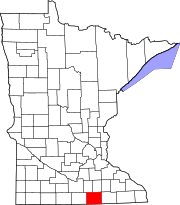2010 census
As of the census [9] of 2010, there were 297 people, 120 households, and 84 families residing in the city. The population density was 1,650.0 inhabitants per square mile (637.1/km2). There were 130 housing units at an average density of 722.2 per square mile (278.8/km2). The racial makeup of the city was 98.3% White, 0.3% from other races, and 1.3% from two or more races. Hispanic or Latino of any race were 3.7% of the population.
Of the 120 households in the 2010 census, a total of 43, or 35.8%, had children under the age of 18 living with them, 65 (54.2%) were married couples living together, 13 (10.8%) had a female householder with no husband present, 6 (5.0%) had a male householder with no wife present, and 36 (30.0%) were non-families. Meanwhile, 30, or 25.0% of all households were made up of individuals, and 11 (9.2%) were a person living alone, age 65 years or older. The average household size was 2.48 persons, and the average family size was 2.95 persons.
The median age in the city was 38.9 years. Of Freeborn's 297 residents, 75, or 25.3% of residents were children under the age of 18; 23 (7.7%) were between the ages of 18 and 24; 70 (23.6%) were age 25 to 44; 83 (28.0%) were age 45 to 64; and 46 (15.5%) were 65 years of age or older. The gender makeup of the 297 residents was 151 (50.8%) males and 146 (49.2%) females.
2000 census
As of the census [3] of 2000, there were 305 people, or 1,706.2 persons per square mile (654.2/km2). There were 136 housing units, at an average density of 760.8 units per square mile. (291.7/km2). The racial makeup of the city was 99.02% White, 0.33% Native American, and 0.66% from two or more races. Hispanic or Latino of any race were 0.33% of the population.
For several years, Freeborn's summertime population would grow to approximately 450, due to the presence of the Jewish Chabad-Lubavitch Yeshiva summer camp, headquartered in the town's former K-12 school building, as well as the adjacent 8-acre campus. This camp brought nearly 150 boys to town, as well as camp counselors and educational staff, primarily from the Crown Heights area of the borough of Brooklyn, in New York City. The camp operated for several years, and discontinued after the 2014 season.
Of the 136 households, 23.7% had children under the age of 18 living with them, 59.5% were married couples living together, 4.6% had a female householder with no husband present, and 32.8% were non-families. 28.2% of all households were made up of individuals, and 14.5% had someone living alone who was 65 years of age or older. The average household size was 2.33 and the average family size was 2.81.
In the city, the population was spread out, with 20.0% under the age of 18, 7.5% from 18 to 24, 27.2% from 25 to 44, 25.2% from 45 to 64, and 20.0% who were 65 years of age or older. The median age was 41 years. For every 100 females, there were 99.3 males. For every 100 females age 18 and over, there were 103.3 males.
The median income for a household in the city was $38,500, and the median income for a family was $47,031. Males had a median income of $32,321 versus $20,000 for females. The per capita income for the city was $18,149. About 2.4% of families and 6.3% of the population were below the poverty line, including 5.3% of those under the age of eighteen and 6.5% of those 65 or over.

